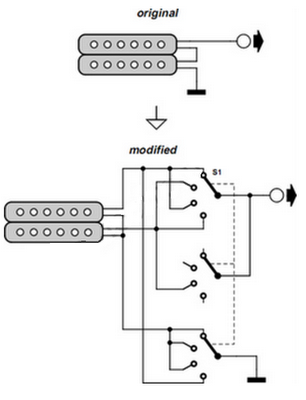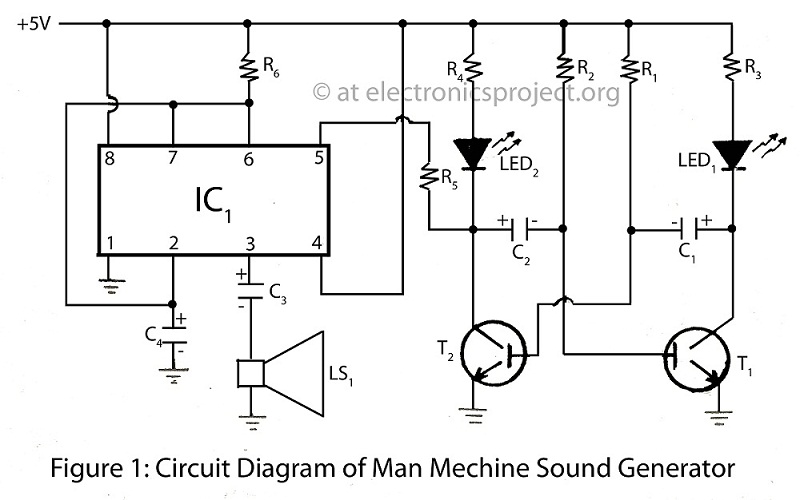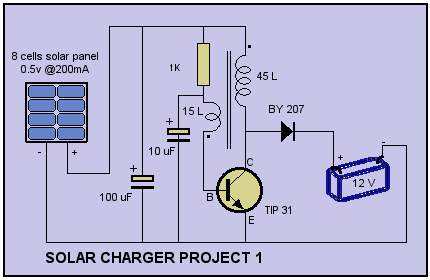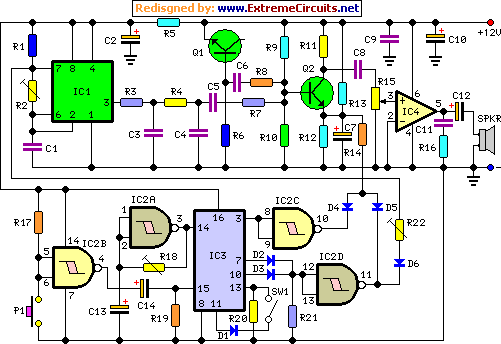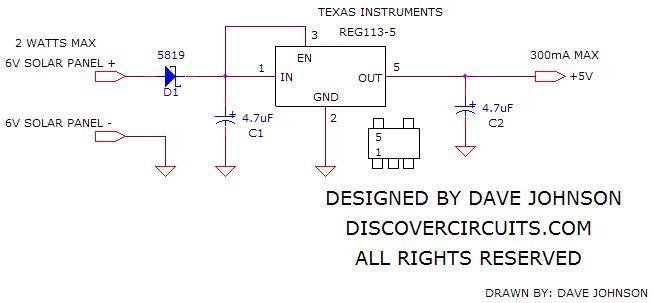
Sola Sound ToneBender
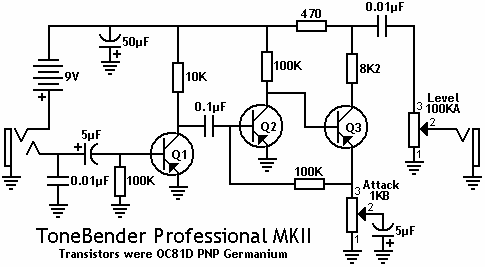
This is probably one of the most legendary fuzz pedals that has ever existed, and for good reason too! This thing can produce some completely saturated fuzz that is capable of slipping into feedback easily if you crank it up loud enough. Supposedly, this is the fuzz pedal that Jimmy Page used on the first couple of Led Zeppelin albums, which makes it even more famous. Below is a picture of the circuit board in a ToneBender MKII. Note the silver Mullard OC81D transistors. There are a lot of schematics on the internet that don't have the 0.01µF capacitor on the input jack side of the input capacitor, but in the original ToneBender MKIIs, there was one there. This capacitor helps to get rid of some of the intense treble that this circuit has without it. It is recommended to replace the 8K2 resistor on the collector of Q3 with a 20K trimpot which will allow adjustment of Q3's collector voltage to -4.5VDC. A pulldown resistor can be added to the input of the circuit and a reverse polarity protection diode to help protect those expensive Germanium transistors. Another nice tweak is to replace the 470-ohm resistor in the original circuit with a 1K or 1K2, which will boost the available output quite a bit. The original OC81D transistors will be very hard to find and very expensive if found. The Marshall Supa Fuzz is an "almost twin" of the ToneBender MKII. The only differences between the two: the input capacitor is 10µF instead of 5µF, the bypass capacitor on the "attack" pot is 10µF instead of 5µF, Q2's collector resistor is 47K instead of 100K, the resistor from the base of Q1 to ground is 10K instead of 100K, and the transistors are OC75 instead of OC81D. The sound of the pedals should be nearly the same, although the Supa Fuzz will probably be bassier since the input capacitor is quite a bit larger, especially with that 0.01µF from input to ground still in place, which removes even more treble. As part of a recent trend of "retro" effects pedals becoming very popular again, Sola Sound reissued the ToneBender MKII Professional. The pedal wasn't equipped with the original three-transistor MKII circuit, but rather a modified version of the Fuzz Face. The schematic of the MKII reissue pedal shows that there have been a couple of changes and add-ons to the Fuzz Face circuit. The two most notable additions are the 220pF and 10pF capacitors that are across the collector-base of Q1 and Q2 respectively. These two added capacitors help to smooth out the sound of the pedal, as well as to remove some high-end from the circuit. The input capacitor has been increased from 2.2µF to 4.7µF, and the output capacitor has also been increased from 0.01µF to 0.1µF. These two changes will certainly increase the bass response of the circuit, but it may be too bassy for some players, depending upon their setup. The "level" pot has been changed from 500KA to 100KA to help remove some of the muddiness from the circuit.
The ToneBender MKII circuit is a classic example of a silicon-based fuzz pedal, utilizing transistors in a cascading configuration to achieve its distinctive sound. The original design employs three stages of amplification, with each stage contributing to the overall gain and character of the fuzz effect. The use of Mullard OC81D transistors is critical, as these components are known for their warm, musical clipping characteristics.
The input stage typically includes a coupling capacitor, which blocks DC voltage and allows only AC signals (the audio) to pass through. The addition of a 0.01µF capacitor on the input jack helps to attenuate excessive high frequencies, thereby providing a smoother tone. The collector resistor of Q3, when replaced with a trimpot, allows for fine-tuning of the voltage, which can significantly impact the pedal's response and overall tonal quality.
In terms of modifications, the introduction of a pulldown resistor at the input stage is advisable to prevent unwanted noise and ensure a clean signal path. The reverse polarity protection diode is a crucial addition for safeguarding the sensitive Germanium transistors from damage due to incorrect power supply connections.
The comparison with the Marshall Supa Fuzz highlights the subtle design choices that differentiate these two similar pedals. The variations in capacitor values and transistor types can result in noticeable differences in tonal output, with the Supa Fuzz potentially offering a more pronounced bass response due to its larger input capacitor.
The reissue of the ToneBender MKII by Sola Sound reflects the ongoing interest in vintage gear and the desire to recreate classic sounds. However, it is important to note the deviations from the original circuit, such as the modifications to the Fuzz Face design, which may alter the expected tonal characteristics. The inclusion of additional capacitors for smoothing and the adjustments to the input and output capacitors are indicative of modern design trends aimed at achieving a more versatile pedal that can cater to a wider range of musical styles.
Overall, the ToneBender MKII and its variants represent significant milestones in the evolution of fuzz pedals, blending historical significance with ongoing innovation in the realm of guitar effects.This is probably one of the most legendary fuzz pedals that has ever existed, and for good reason too! This thing can produce some completely saturated fuzz that is capable of slipping into feedback easily if you crank it up loud enough.
I just can't say enough about this pedal. This is, without a doubt, my all-time favorite fuzzer. It's a genuine kick in the teeth that will have a permanent spot in my setup. Supposedely, this is the fuzz pedal that Jimmy Page used on the first couple of Led Zeppelin albums, which makes it even more famous. Below is a picture of the circuit board in a ToneBender MKII. Note the silver Mullard OC81D transistors There are a lot of schematics on the internet that don't have the 0.01µF capacitor on the input jack side of the input capacitor, but in the original ToneBender MKIIs, there was one there. This capacitor helps to get rid of some of the intense treble that this circuit has without it. I would recommend that you replace the 8K2 resistor on the collector of Q3 with a 20K trimpot which will allow you to adjust Q3s collector voltage to -4.5VDC.
I would also add a pulldown resistor to the input of the circuit and a reverse polarity protection diode to help protect those expensive Germanium transistors. Another nice tweak is to replace the 470-ohm resistor in the original circuit with a 1K or 1K2, which will boost the available output quite a bit.
The original OC81D transistors will be very hard to find...and very expensive if you do find them. The Marshall Supa Fuzz is an "almost twin" of the ToneBender MKII. The only differences between the two: the input capacitor is 10µF instead of 5µF, the bypass capacitor on the "attack" pot is 10µF instead of 5µF, Q2's collector resistor is 47K instead of 100K, the resistor from the base of Q1 to ground is 10K instead of 100K, and the transistors are OC75 instead of OC81D. The sound of the pedals should be nearly the same, although the Supa Fuzz will probably be bassier since the input capacitor is quite a bit larger, especially with that 0.01µF from input to ground still in place, which removes even more treble.
As part of a recent trend of "retro" effects pedals becoming very popular again, Sola Sound reissued the ToneBender MKII Professional... sort of. The pedal wasn't equipped with the original three-transistor MKII circuit, but rather a modified version of the Fuzz Face.
If you take a look at the schematic of the MKII reissue pedal below, you'll see that there have been a couple of changes and add-ons to the Fuzz Face circuit. The two most notable additions are the 220pF and 10pF capacitors that are across the collector-base of Q1 and Q2 respectively.
These two added capacitors help to smooth out the sound of the pedal, as well as to remove some high-end from the circuit. The input capacitor has been increased from 2.2µF to 4.7µF, and the output capacitor has also been increased...from 0.01µF to 0.1µF.
These two changes will certainly increase the bass response of the circuit...but it may be too bassy for some players, depending upon their setup. The "level" pot has been changed from 500KA to 100KA to help remove some of the muddiness from the circuit.
🔗 External reference
The ToneBender MKII circuit is a classic example of a silicon-based fuzz pedal, utilizing transistors in a cascading configuration to achieve its distinctive sound. The original design employs three stages of amplification, with each stage contributing to the overall gain and character of the fuzz effect. The use of Mullard OC81D transistors is critical, as these components are known for their warm, musical clipping characteristics.
The input stage typically includes a coupling capacitor, which blocks DC voltage and allows only AC signals (the audio) to pass through. The addition of a 0.01µF capacitor on the input jack helps to attenuate excessive high frequencies, thereby providing a smoother tone. The collector resistor of Q3, when replaced with a trimpot, allows for fine-tuning of the voltage, which can significantly impact the pedal's response and overall tonal quality.
In terms of modifications, the introduction of a pulldown resistor at the input stage is advisable to prevent unwanted noise and ensure a clean signal path. The reverse polarity protection diode is a crucial addition for safeguarding the sensitive Germanium transistors from damage due to incorrect power supply connections.
The comparison with the Marshall Supa Fuzz highlights the subtle design choices that differentiate these two similar pedals. The variations in capacitor values and transistor types can result in noticeable differences in tonal output, with the Supa Fuzz potentially offering a more pronounced bass response due to its larger input capacitor.
The reissue of the ToneBender MKII by Sola Sound reflects the ongoing interest in vintage gear and the desire to recreate classic sounds. However, it is important to note the deviations from the original circuit, such as the modifications to the Fuzz Face design, which may alter the expected tonal characteristics. The inclusion of additional capacitors for smoothing and the adjustments to the input and output capacitors are indicative of modern design trends aimed at achieving a more versatile pedal that can cater to a wider range of musical styles.
Overall, the ToneBender MKII and its variants represent significant milestones in the evolution of fuzz pedals, blending historical significance with ongoing innovation in the realm of guitar effects.This is probably one of the most legendary fuzz pedals that has ever existed, and for good reason too! This thing can produce some completely saturated fuzz that is capable of slipping into feedback easily if you crank it up loud enough.
I just can't say enough about this pedal. This is, without a doubt, my all-time favorite fuzzer. It's a genuine kick in the teeth that will have a permanent spot in my setup. Supposedely, this is the fuzz pedal that Jimmy Page used on the first couple of Led Zeppelin albums, which makes it even more famous. Below is a picture of the circuit board in a ToneBender MKII. Note the silver Mullard OC81D transistors There are a lot of schematics on the internet that don't have the 0.01µF capacitor on the input jack side of the input capacitor, but in the original ToneBender MKIIs, there was one there. This capacitor helps to get rid of some of the intense treble that this circuit has without it. I would recommend that you replace the 8K2 resistor on the collector of Q3 with a 20K trimpot which will allow you to adjust Q3s collector voltage to -4.5VDC.
I would also add a pulldown resistor to the input of the circuit and a reverse polarity protection diode to help protect those expensive Germanium transistors. Another nice tweak is to replace the 470-ohm resistor in the original circuit with a 1K or 1K2, which will boost the available output quite a bit.
The original OC81D transistors will be very hard to find...and very expensive if you do find them. The Marshall Supa Fuzz is an "almost twin" of the ToneBender MKII. The only differences between the two: the input capacitor is 10µF instead of 5µF, the bypass capacitor on the "attack" pot is 10µF instead of 5µF, Q2's collector resistor is 47K instead of 100K, the resistor from the base of Q1 to ground is 10K instead of 100K, and the transistors are OC75 instead of OC81D. The sound of the pedals should be nearly the same, although the Supa Fuzz will probably be bassier since the input capacitor is quite a bit larger, especially with that 0.01µF from input to ground still in place, which removes even more treble.
As part of a recent trend of "retro" effects pedals becoming very popular again, Sola Sound reissued the ToneBender MKII Professional... sort of. The pedal wasn't equipped with the original three-transistor MKII circuit, but rather a modified version of the Fuzz Face.
If you take a look at the schematic of the MKII reissue pedal below, you'll see that there have been a couple of changes and add-ons to the Fuzz Face circuit. The two most notable additions are the 220pF and 10pF capacitors that are across the collector-base of Q1 and Q2 respectively.
These two added capacitors help to smooth out the sound of the pedal, as well as to remove some high-end from the circuit. The input capacitor has been increased from 2.2µF to 4.7µF, and the output capacitor has also been increased...from 0.01µF to 0.1µF.
These two changes will certainly increase the bass response of the circuit...but it may be too bassy for some players, depending upon their setup. The "level" pot has been changed from 500KA to 100KA to help remove some of the muddiness from the circuit.
🔗 External reference
